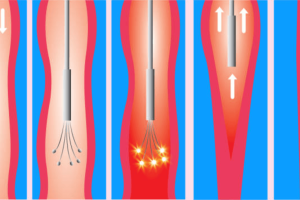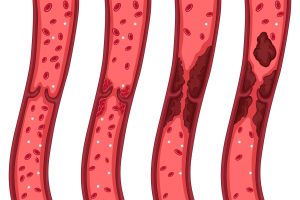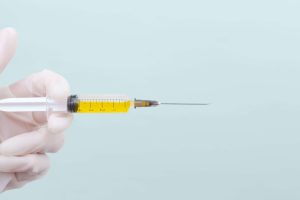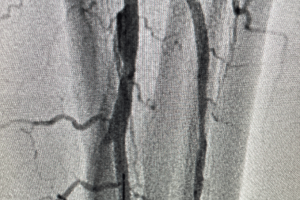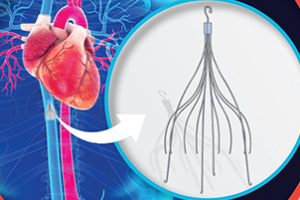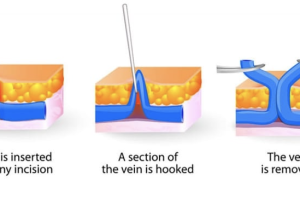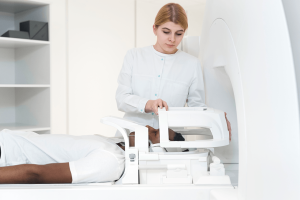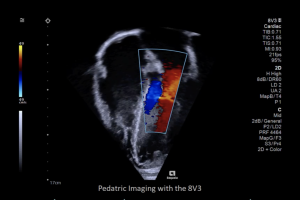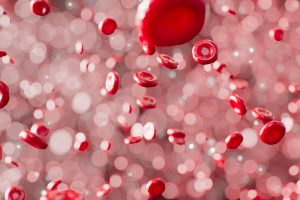The heart never takes a break. The heart is a strong muscle that never stops exercising, not for a minute. Every minute it needs blood, nourishment and oxygen. At Amarillo Heart Institute, we understand the importance of keeping your heart healthy and functioning at its best. We believe that a healthy heart is the foundation of a healthy life, and our goal is to provide you with all you need to achieve optimal heart health, a happier heart.
Venous Diseases
Veins are blood vessels that carry deoxygenated blood from the body’s tissues back to the heart. Veins have thinner walls and are located closer to the surface of the skin compared to arteries, which carry oxygenated blood away from the heart to the body’s tissues. Venous blood is typically darker in color compared to arterial blood, and it moves more slowly because it is not under high pressure like arterial blood. The venous system is an important part of the circulatory system, and plays a crucial role in maintaining the body’s overall health and well-being.
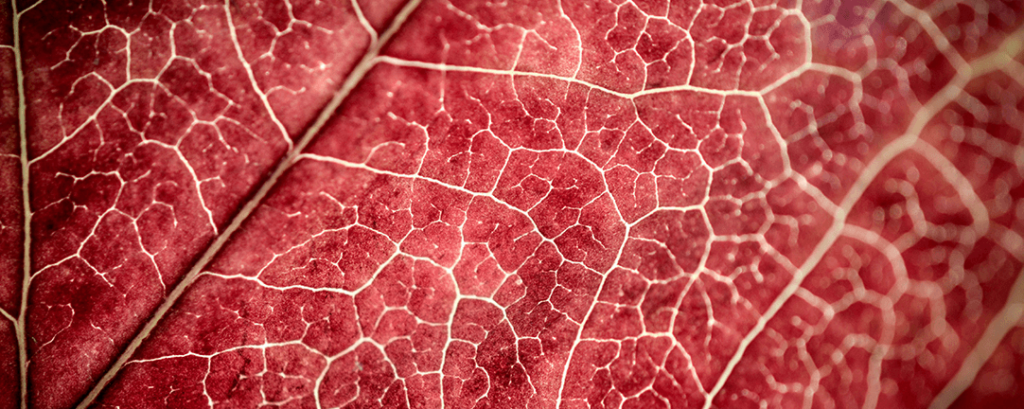
Venous Diseases
Venous diseases are a group of medical conditions that affect the veins of the body, which are the blood vessels that carry blood back to the heart. There are several types of venous diseases, each with its own causes, symptoms, and treatments.
Chronic Venous Insufficiency (CVI)
Chronic venous insufficiency (CVI) is a condition that occurs when the veins in the legs do not function properly, leading to impaired blood flow back to the heart. This can cause blood to pool in the veins, leading to symptoms such as leg pain, swelling, and ulcers.
CVI can be caused by a variety of factors, including damage to the veins from injury or surgery, obesity, pregnancy, and prolonged periods of standing or sitting. The condition is also more common in older adults.
Symptoms of CVI can vary depending on the severity of the condition, but may include leg pain, swelling, varicose veins, skin changes such as discoloration or thickening, and ulcers. In severe cases, CVI can lead to complications such as deep vein thrombosis (DVT) or pulmonary embolism (PE).
Treatment for CVI typically includes lifestyle changes such as exercise, weight loss, and avoiding long periods of sitting or standing. Compression stockings may also be recommended to help improve blood flow in the legs. In more severe cases, medications or surgery may be necessary to treat the underlying cause of the condition or to manage symptoms.
Venous / Pulmonary Thromboembolic Disease
Venous thromboembolic disease (VTE) is a condition in which a blood clot forms in a vein, typically in the legs or pelvis. If the clot breaks free and travels to the lungs, it can cause a life-threatening condition called pulmonary embolism (PE).
It can include deep vein thrombosis (DVT), that specifically refers to the formation of a blood clot in a deep vein, most commonly in the leg, which can break loose and travel to the lungs, causing a potentially life-threatening. DVT can cause pain, swelling, and redness in the affected area. Treatment usually involves blood thinners and compression stockings, and in severe cases, Thrombectomy surgery.

Image by brgfx on Freepik
VTE can occur in people with certain risk factors, including a personal or family history of blood clots, prolonged immobility due to surgery or injury, pregnancy, use of hormonal contraceptives or hormone replacement therapy, and certain medical conditions such as cancer or inflammatory bowel disease.
Symptoms of VTE can include pain, swelling, and redness in the affected area, as well as warmth and tenderness. Symptoms of PE can include sudden shortness of breath, chest pain, rapid heartbeat, coughing up blood, and feeling lightheaded or faint.
Diagnosis of VTE and PE typically involves imaging tests such as ultrasound, CT scan, or MRI. Treatment may include blood-thinning medications to prevent further clot formation and to help dissolve the existing clot. In severe cases, medical procedures such as thrombolysis or surgery may be necessary. Lifestyle changes such as exercise and avoiding prolonged periods of sitting or standing may also be recommended to reduce the risk of VTE.
May - Thurner Syndrome
May-Thurner Syndrome (MTS) is a condition in which the left iliac vein, which is the vein that carries blood from the left leg, is compressed by the right iliac artery. This can lead to narrowing or blockage of the left iliac vein, which can cause blood clots to form in the affected leg.
MTS is more common in women than in men, and it usually occurs in people between the ages of 20 and 50. It is often associated with a history of deep vein thrombosis (DVT), which is a blood clot that forms in a deep vein, usually in the leg.
The symptoms of MTS can include swelling, pain, or redness in the affected leg, as well as warmth or tenderness in the area. Some people may also develop varicose veins or skin ulcers on the affected leg.
Diagnosis of MTS typically involves imaging tests such as ultrasound, CT scan, or MRI, which can show the compression of the left iliac vein. A venogram, which is a type of X-ray that uses contrast dye to visualize the veins, may also be performed to confirm the diagnosis.
Treatment for MTS typically involves anticoagulant medication, which helps to prevent blood clots from forming. In some cases, a procedure called venous stenting may be performed, which involves inserting a small mesh tube called a stent into the compressed vein to keep it open. Usually the Iliac Vein Angioplasty and stent.
If left untreated, MTS can lead to complications such as chronic leg pain, swelling, or skin ulcers, as well as an increased risk of DVT and pulmonary embolism (a potentially life-threatening condition in which a blood clot travels to the lungs)
Manifestation of Venous Diseases
These venous diseases can manifest in different ways depending on their severity: In order from least to most severe, we can find:
Spider & Reticular Veins
Spider veins are small, dilated blood vessels that are visible on the surface of the skin, usually in the legs or face. They are caused by vein insufficiency and they are usually not a serious health problem, but they can be cosmetically bothersome. Treatment options include sclerotherapy and laser therapy.

Vericose Veins
Varicose veins are enlarged, twisted veins that are usually found in the legs. They occur when the valves in the veins do not work properly, causing blood to pool and the veins to bulge. Varicose veins can cause pain, swelling, and skin changes, but they are usually not a serious health problem. Treatment options include lifestyle changes, compression stockings, and medical procedures such as sclerotherapy, phlebectomy or surgery.
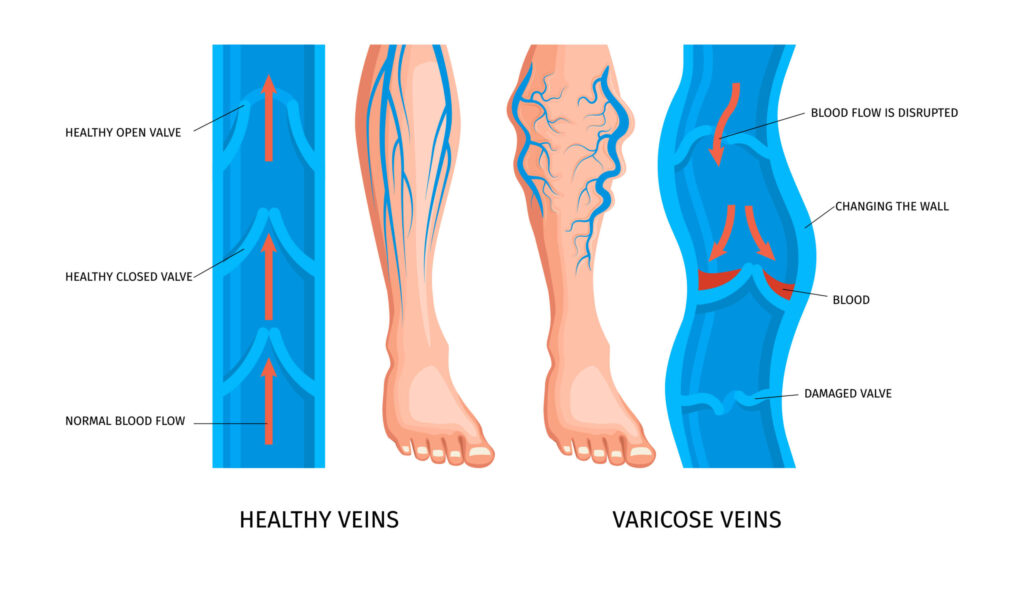
Image by macrovector on Freepik
Venous Stasis & Stasis Dermatitis
Venous stasis is a condition that occurs when there is poor blood flow through the veins in the legs, usually due to damaged or weakened valves. When the valves in the veins are not working properly, blood can pool in the veins, leading to increased pressure in the veins and reduced blood flow to the surrounding tissues.
One of the complications of venous stasis is stasis dermatitis, a skin condition that occurs when there is a build-up of fluid and blood cells in the tissues of the lower legs. This can cause the skin to become discolored, swollen, and itchy, and may lead to the development of ulcers or sores in the affected area.
Treatment for venous stasis and stasis dermatitis typically involves compression stockings, medications, elevating the legs, and exercising regularly.
Edema
An abnormal accumulation of fluid in the tissues, particularly in the legs and ankles. Edema can occur as a result of a number of conditions that affect the veins, including deep vein thrombosis (DVT), chronic venous insufficiency (CVI), and varicose veins.
Edema in venous diseases can be treated through a variety of methods, depending on the underlying cause. Treatment may involve compression stockings, which can help to improve blood flow and reduce swelling, as well as medications such as diuretics, which help to remove excess fluid from the body. In severe cases, thrombolysis, thrombectomy surgery or other procedures may be necessary to correct the underlying problem and improve blood flow.
Venous Ulcers
Venous ulcers, also known as stasis ulcers, are wounds that develop on the legs and feet as a result of poor circulation in the veins. They are most commonly found on the inner ankle or calf and can be painful and slow to heal.
Venous ulcers are typically caused by chronic venous insufficiency.
Symptoms of venous ulcers include redness, swelling, pain in the affected area and wounds.
Treatment for venous ulcers typically involves the use of compression stockings, medications, or lifestyle changes to promote healthy blood flow.
Phlegmasia Cerulea Dolens
Phlegmasia cerulea dolens (PCD) is a rare but serious medical condition that involves the sudden and severe obstruction of a deep vein in the leg, typically as a result of a blood clot. This obstruction can lead to decreased blood flow to the affected limb, causing it to become swollen, painful, and discolored (may turn blue or purple in color due to the lack of blood flow). In severe cases, the lack of oxygen and nutrients to the tissues can lead to tissue damage and even amputation.
PCD is more common in women, particularly those who are pregnant or have recently given birth. Other risk factors for PCD include a history of blood clots, cancer, and certain medical conditions that increase the risk of blood clotting.
Treatment for PCD typically involves anticoagulant medication, which helps to prevent further blood clots from forming. In some cases, a procedure called thrombolysis (injecting medication directly into the clot to dissolve it).

Venous Diseases Causes:
There are several factors that can contribute to the development of venous diseases, including:
Genetics: A family history of venous diseases, such as varicose veins or deep vein thrombosis (DVT), can increase the risk of developing these conditions.
Age: As we age, the valves in our veins can weaken or become damaged, which can lead to blood pooling in the veins and the development of varicose veins or chronic venous insufficiency (CVI).
Gender: Women are more likely than men to develop varicose veins and other venous diseases, possibly due to hormonal changes that occur during pregnancy and menopause.
Pregnancy: The increased pressure on the veins in the pelvis and legs during pregnancy can increase the risk of developing varicose veins and CVI.
Obesity: Excess weight can put additional pressure on the veins and increase the risk of developing venous diseases.
Prolonged sitting or standing: Long periods of sitting or standing can increase pressure on the veins in the legs, leading to the development of varicose veins or DVT.
Injury or trauma: Damage to the veins due to injury or trauma can increase the risk of developing DVT.
Medical conditions: Certain medical conditions, such as cancer, heart failure, and inflammatory bowel disease, can increase the risk of developing DVT.
Overall, venous diseases can have complex and multifactorial causes, and the development of these conditions may be influenced by a combination of genetic, lifestyle, and environmental factors.
How to diagnose Venous Diseases
The diagnosis of venous diseases typically involves a combination of medical history, physical examination, and diagnostic tests. Here are some of the common methods used to diagnose venous diseases:
Medical history: Your healthcare provider will ask about your symptoms, medical history, and any risk factors for venous diseases.
Physical examination: Your healthcare provider will examine your legs or the affected area, looking for signs of swelling, discoloration, and varicose veins. They may also check for tenderness, warmth, or redness, which could be signs of DVT.
Ultrasound: This is a non-invasive imaging test that uses sound waves to create images of the veins and check for blood flow abnormalities. Duplex ultrasound is commonly used to diagnose varicose veins, CVI, and DVT.
Venography: This is an invasive imaging test that involves injecting a contrast dye into a vein and taking X-ray images to visualize the flow of blood. Venography is typically used to diagnose DVT when duplex ultrasound is inconclusive, using X-ray machines or other imaging technologies such as computed tomography (CT) or magnetic resonance imaging (MRI) machines
Magnetic resonance venography (MRV): These non-invasive imaging tests use magnetic fields or X-rays to create detailed images of the veins and diagnose venous diseases.
Computed tomography venography (CTV): medical imaging technique used to visualize the veins in the body. It is a type of CT scan that uses X-rays to create detailed, three-dimensional images of the veins.
- Blood tests: Your healthcare provider may order blood tests to check for clotting disorders or other medical conditions that could increase the risk of developing DVT.
The choice of diagnostic test will depend on the specific venous disease being investigated and the individual’s medical history and symptoms.
How to treat Venous Diseases
The treatment of venous diseases depends on the specific condition and its severity. Here are some of the common treatments for venous diseases:
Lifestyle changes: Simple lifestyle changes can help reduce symptoms of venous diseases, such as varicose veins and CVI. (regular exercise, healthy weight, avoiding prolonged standing or sitting, and elevating the legs when resting)
Compression stockings: Wearing compression stockings can help improve blood flow in the legs and reduce swelling and discomfort. These stockings are available in different compression levels and can be purchased over-the-counter or prescribed by a healthcare provider.
Sclerotherapy: A solution is injected into the affected veins, causing them to shrink and disappear.
Thrombectomy: Thrombectomy is a medical procedure in which a blood clot is surgically removed or mechanically broken up to restore blood flow to the affected area.
Thrombolysis: Thrombolysis is a medical procedure that is used to dissolve blood clots that have formed inside blood vessels or arteries. It involves the use of medications called thrombolytics or fibrinolytics that are designed to break down the clot and restore blood flow to the affected area.
Iliac Vein Angioplasty & Stent placement : Vein angioplasty and stent placement are medical procedures used to treat blockages or narrowings in the veins, typically in the legs.
Radiofrequency & Laser ablation: A catheter is inserted into the affected veins, and radiofrequency energy is used to close them off.
Phlebectomy: Small incisions are made in the skin, and the affected veins are removed through the incisions.
Inferior Vena Cava filter (IVC) & IVC Filter Removal: An inferior vena cava (IVC) filter is a medical device that is inserted into the IVC, a large vein that carries blood from the lower body to the heart, to catch blood clots and prevent them from reaching the lungs. IVC filter removal is a procedure to remove the device once it is no longer needed, typically when the risk of blood clots has passed.
Surgery: In some cases, surgery may be necessary to remove the affected veins or repair damaged valves. This is usually reserved for severe cases of venous diseases that are not responsive to other treatments.
Medications: Blood thinners, such as heparin or warfarin, may be prescribed to treat DVT and prevent blood clots from forming. Other medications, such as venoactive drugs, may be used to improve blood flow and reduce swelling in the legs.
The choice of treatment will depend on the specific venous disease, the individual’s overall health, and the severity of the condition. It’s important to work with a healthcare provider to determine the best course of treatment for your specific situation.

